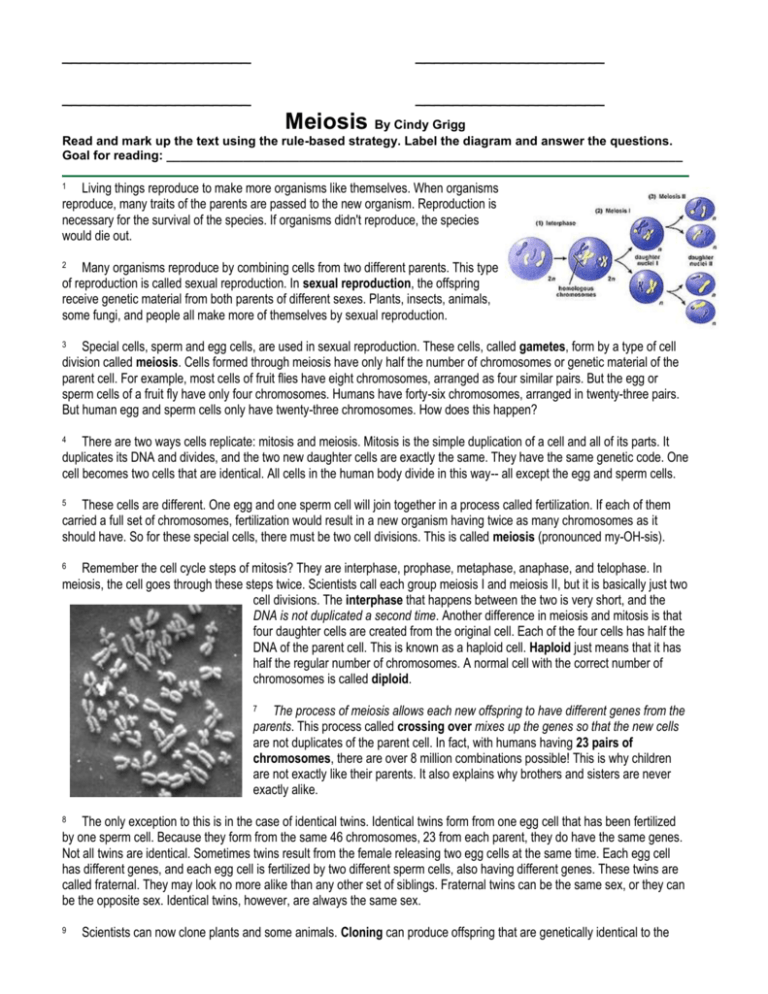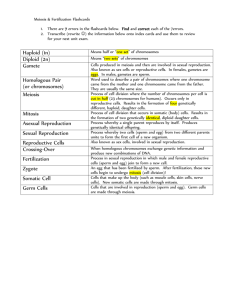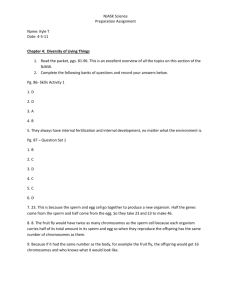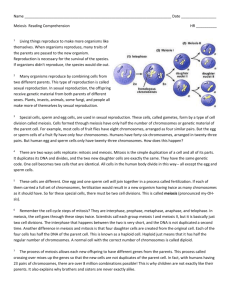Meiosis By Cindy Grigg Read and mark up the text using the rule
advertisement

____________________ ____________________ ____________________ ____________________ Meiosis By Cindy Grigg Read and mark up the text using the rule-based strategy. Label the diagram and answer the questions. Goal for reading: __________________________________________________________________________ Living things reproduce to make more organisms like themselves. When organisms reproduce, many traits of the parents are passed to the new organism. Reproduction is necessary for the survival of the species. If organisms didn't reproduce, the species would die out. 1 Many organisms reproduce by combining cells from two different parents. This type of reproduction is called sexual reproduction. In sexual reproduction, the offspring receive genetic material from both parents of different sexes. Plants, insects, animals, some fungi, and people all make more of themselves by sexual reproduction. 2 Special cells, sperm and egg cells, are used in sexual reproduction. These cells, called gametes, form by a type of cell division called meiosis. Cells formed through meiosis have only half the number of chromosomes or genetic material of the parent cell. For example, most cells of fruit flies have eight chromosomes, arranged as four similar pairs. But the egg or sperm cells of a fruit fly have only four chromosomes. Humans have forty-six chromosomes, arranged in twenty-three pairs. But human egg and sperm cells only have twenty-three chromosomes. How does this happen? 3 There are two ways cells replicate: mitosis and meiosis. Mitosis is the simple duplication of a cell and all of its parts. It duplicates its DNA and divides, and the two new daughter cells are exactly the same. They have the same genetic code. One cell becomes two cells that are identical. All cells in the human body divide in this way-- all except the egg and sperm cells. 4 These cells are different. One egg and one sperm cell will join together in a process called fertilization. If each of them carried a full set of chromosomes, fertilization would result in a new organism having twice as many chromosomes as it should have. So for these special cells, there must be two cell divisions. This is called meiosis (pronounced my-OH-sis). 5 Remember the cell cycle steps of mitosis? They are interphase, prophase, metaphase, anaphase, and telophase. In meiosis, the cell goes through these steps twice. Scientists call each group meiosis I and meiosis II, but it is basically just two cell divisions. The interphase that happens between the two is very short, and the DNA is not duplicated a second time. Another difference in meiosis and mitosis is that four daughter cells are created from the original cell. Each of the four cells has half the DNA of the parent cell. This is known as a haploid cell. Haploid just means that it has half the regular number of chromosomes. A normal cell with the correct number of chromosomes is called diploid. 6 The process of meiosis allows each new offspring to have different genes from the parents. This process called crossing over mixes up the genes so that the new cells are not duplicates of the parent cell. In fact, with humans having 23 pairs of chromosomes, there are over 8 million combinations possible! This is why children are not exactly like their parents. It also explains why brothers and sisters are never exactly alike. 7 The only exception to this is in the case of identical twins. Identical twins form from one egg cell that has been fertilized by one sperm cell. Because they form from the same 46 chromosomes, 23 from each parent, they do have the same genes. Not all twins are identical. Sometimes twins result from the female releasing two egg cells at the same time. Each egg cell has different genes, and each egg cell is fertilized by two different sperm cells, also having different genes. These twins are called fraternal. They may look no more alike than any other set of siblings. Fraternal twins can be the same sex, or they can be the opposite sex. Identical twins, however, are always the same sex. 8 9 Scientists can now clone plants and some animals. Cloning can produce offspring that are genetically identical to the ____________________ ____________________ ____________________ ____________________ parent offspring. Only one parent is needed. Cloning uses cells or tissues from the body of the parent organism to produce a new organism with identical traits. Copyright © 2007 edHelper Part 1 Label diagram 1. Which kinds of cells take part in sexual reproduction? a. Brain and body cells b. Skin and heart cells c. Egg and sperm cells 2. What are gametes? a. Egg and sperm cells b. Brain and body cells c. Skin and heart cells 3. All cells in the human body, except egg and sperm cells, duplicate by: a. Meiosis b. Sexual reproduction c. Fission d. Mitosis 4. Egg and sperm cells duplicate by: a. Meiosis b. Fission c. Mitosis 5. Mitosis results in: a. Four cells with identical genes b. Two cells with identical genes c. Four cells with different genes d. Two cells with different genes 6. Meiosis results in: a. Four cells with identical genes b. Four cells with different genes c. Two cells with different genes d. Two cells with identical genes 7. Diploid cells have: a. Twice the number of chromosomes of the parent organism b. The regular number of chromosomes of the parent organism c. Half the chromosomes of the parent organism 8. Haploid cells have: a. Twice the number of chromosomes of the parent organism b. The regular number of chromosomes of the parent organism c. Half the chromosomes of the parent organism ____________________ ____________________ ____________________ ____________________ Meiosis - Answer Key 1 2 3 4 5 6 7 8 Egg and sperm cells Egg and sperm cells Mitosis Meiosis Two cells with identical genes Four cells with different genes The regular number of chromosomes of the parent organism Half the chromosomes of the parent organism ____________________ ____________________ ____________________ ____________________








